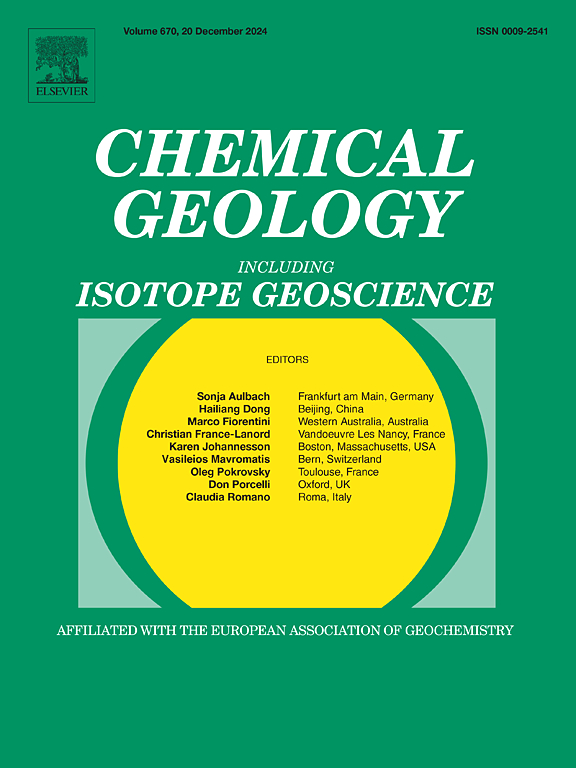早期岩浆和晚期硫化物的 Sm/Nd 比率差异:流体和钕移动性的作用
IF 3.6
2区 地球科学
Q1 GEOCHEMISTRY & GEOPHYSICS
引用次数: 0
摘要
本文介绍了对芬诺斯卡迪亚地盾铜-镍-PGE 层状复合体中的硫化物矿物和全岩样本进行 SmNd 研究的结果。使用 SmNd 方法分析了每个复合体中的共生(早期)和外生(晚期)硫化物。晚期硫化物矿物的 Sm/Nd 值较低(147Sm/144Nd 比值通常在 0.02-0.07 之间),这与 Nd 相对于 Sm 的流动性增加有关,从而导致这些硫化物中 Nd 相对于 Sm 过量。与此同时,在矿石形成的岩浆阶段沉积下来的早期硫化物通常表现出较高的 Sm/Nd 值(147Sm/144Nd 比值经常高于 0.07)。此外,硫化物矿物的 SmNd 同位素数据被用于确定两个铜-镍-PGE 复合体--Nyud-II(俄罗斯 Monchegorsk 地区)和 Ahmavaara(芬兰)的成矿过程的日期。测定了这些复合体中合成矿石和变质矿石的 SmNd 年龄。合成矿石形成于 2496 ± 36 Ma(Nyud-II)和 2441 ± 93 Ma(Ahmavaara),而变质矿石形成于 1940 ± 32 Ma(Nyud-II)和 1904 ± 24 Ma(Ahmavaara)。因此,SmNd 等时线可得出硫化物成矿的时间及其与含硫化物岩石年龄的关系,而硫化物中的 Sm/Nd 比率则有助于了解矿石形成的过程。对全部同位素数据集(本研究和其他已公布的数据)的综合分析表明,利用钐钕同位素数据追踪硫化物成矿序列具有潜力,一些热液矿床的硫化物成矿序列已得到证实。然而,岩浆硫化物的这一序列尚未得到证实;这为进一步研究提供了可能性。本文章由计算机程序翻译,如有差异,请以英文原文为准。
Differences in Sm/Nd ratios between early magmatic and late sulfides: The role of fluids and Nd mobility
This paper presents the results of a Sm![]() Nd study of sulfide minerals and whole-rock samples from Cu-Ni-PGE layered complexes of the Fennoscandian Shield. Syngenetic (early) and epigenetic (late) sulfides were analyzed in each complex using the Sm
Nd study of sulfide minerals and whole-rock samples from Cu-Ni-PGE layered complexes of the Fennoscandian Shield. Syngenetic (early) and epigenetic (late) sulfides were analyzed in each complex using the Sm![]() Nd method. Late sulfide minerals with low Sm/Nd values (the 147Sm/144Nd ratio is often in the range of 0.02–0.07) are associated with an increased mobility of Nd relative to Sm, resulting in a relative excess of Nd compared to Sm in these sulfides. Simultaneously, early sulfides, which are deposited during the magmatic stage of ore formation, typically exhibit higher Sm/Nd values (the 147Sm/144Nd ratio is frequently above 0.07). Additionally, Sm
Nd method. Late sulfide minerals with low Sm/Nd values (the 147Sm/144Nd ratio is often in the range of 0.02–0.07) are associated with an increased mobility of Nd relative to Sm, resulting in a relative excess of Nd compared to Sm in these sulfides. Simultaneously, early sulfides, which are deposited during the magmatic stage of ore formation, typically exhibit higher Sm/Nd values (the 147Sm/144Nd ratio is frequently above 0.07). Additionally, Sm![]() Nd isotope data for sulfide minerals were used to date ore-forming processes in two Cu-Ni-PGE complexes—Nyud-II (Monchegorsk area, Russia) and Ahmavaara (Finland). The Sm
Nd isotope data for sulfide minerals were used to date ore-forming processes in two Cu-Ni-PGE complexes—Nyud-II (Monchegorsk area, Russia) and Ahmavaara (Finland). The Sm![]() Nd ages of syngenetic and metamorphic ore from these complexes were determined. Syngenetic ores formed at 2496 ± 36 Ma (Nyud-II) and 2441 ± 93 Ma (Ahmavaara), while metamorphic ores formed at 1940 ± 32 Ma (Nyud-II) and 1904 ± 24 Ma (Ahmavaara). Thus, Sm
Nd ages of syngenetic and metamorphic ore from these complexes were determined. Syngenetic ores formed at 2496 ± 36 Ma (Nyud-II) and 2441 ± 93 Ma (Ahmavaara), while metamorphic ores formed at 1940 ± 32 Ma (Nyud-II) and 1904 ± 24 Ma (Ahmavaara). Thus, Sm![]() Nd isochrons yield the timing of sulfide mineralization and its relationship with the ages of the rocks containing it, while Sm/Nd ratios in sulfides help understand the processes of ore formation. A comprehensive analysis of the full isotopic dataset (this study and other published data) showed the potential of using Sm
Nd isochrons yield the timing of sulfide mineralization and its relationship with the ages of the rocks containing it, while Sm/Nd ratios in sulfides help understand the processes of ore formation. A comprehensive analysis of the full isotopic dataset (this study and other published data) showed the potential of using Sm![]() Nd isotope data to trace the sequence of sulfide mineralization, which has been confirmed for some hydrothermal deposits. However, this sequence has not been confirmed for magmatic sulfides; this opens up the possibility for further research.
Nd isotope data to trace the sequence of sulfide mineralization, which has been confirmed for some hydrothermal deposits. However, this sequence has not been confirmed for magmatic sulfides; this opens up the possibility for further research.
求助全文
通过发布文献求助,成功后即可免费获取论文全文。
去求助
来源期刊

Chemical Geology
地学-地球化学与地球物理
CiteScore
7.20
自引率
10.30%
发文量
374
审稿时长
3.6 months
期刊介绍:
Chemical Geology is an international journal that publishes original research papers on isotopic and elemental geochemistry, geochronology and cosmochemistry.
The Journal focuses on chemical processes in igneous, metamorphic, and sedimentary petrology, low- and high-temperature aqueous solutions, biogeochemistry, the environment and cosmochemistry.
Papers that are field, experimentally, or computationally based are appropriate if they are of broad international interest. The Journal generally does not publish papers that are primarily of regional or local interest, or which are primarily focused on remediation and applied geochemistry.
The Journal also welcomes innovative papers dealing with significant analytical advances that are of wide interest in the community and extend significantly beyond the scope of what would be included in the methods section of a standard research paper.
 求助内容:
求助内容: 应助结果提醒方式:
应助结果提醒方式:


